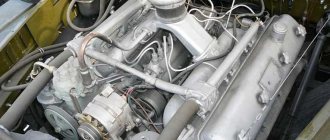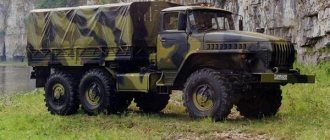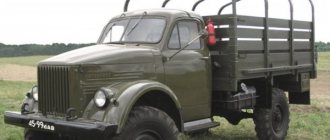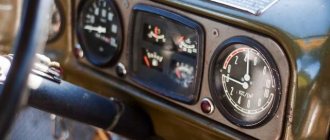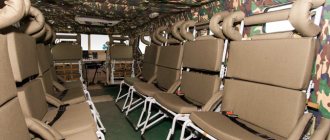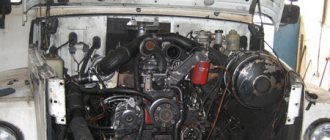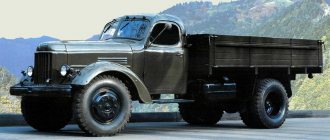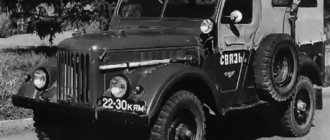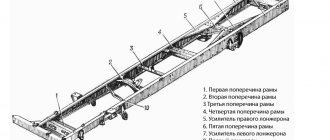It all started back in 1961, when the production of Ural-375 trucks started at a plant in the city of Miass (Ural). Despite the fact that this model was constantly modernized, the truck turned out to be not only reliable, but also durable. However, there were also disadvantages, including working with high octane gasoline. They wanted to remotorize cars back in the 60s. The Urals themselves planned to develop diesel, but due to financial problems their plans failed.
That is why the development of a new engine and gearbox began in Yaroslavl. The diesel engine received a serial number and the name YaMZ-740, while the prototype of the truck began to be called Ural-E4320. Until the fall of 1975, several test tractors and flatbed vehicles were produced. However, production began after the documentation was completed. The entire Ural model range.
Exterior
The body of a domestic car is a metal platform with a folding side at the rear. It is equipped with benches, an awning and removable arches, additional lattice sides. The structure is made in the form of short overhangs, which allows for increased cross-country ability. The total curb weight is 8,265 kg. The weight of the equipment or cargo being transported can reach 6,855 kg, and up to 11.5 tons can be towed.
The standard configuration includes a 3-seater cabin on the frame, which is assembled from thick sheet metal, which is also stamped. As for the glazing, it is made in such a way that the visibility of the driver of the car makes it possible to fully monitor the situation on the road. For this purpose, side rear-view mirrors were made, which are very convenient.
Malfunctions
Any equipment breaks down. Drivers note that breakdowns are typical for the engine, brakes, and gearbox. They note that the first year of operation is normal, but then problems begin.
But opinions differ. Some people note the car’s cross-country ability on the positive side. Even when overloaded, the car runs well. But the engine is very uneconomical. At least 40 liters are consumed per 100 kilometers.
Interior
The presented model is equipped with a cabin with two doors made of metal. It is designed for three people. The driver's seat is adjustable and there is a ventilation system. Some cabin options are equipped with a separate berth. Since the spring of 2009, the Ural-4320 began to be equipped with a new type of cabin made of fiberglass. Operating conditions, controls and seating arrangements have become more comfortable.
How to calculate fuel consumption for Kamaz?
General calculation formula:
- Qh=0.01*Hsanc*S*(1+0.01*D)+Hz*Z.
- Hsanc=Hs+Hw*(Gpr+0.5*q)
- Qh=0.01*(Hsan*S+Hw*W)*(1+0.01*D)
Interesting materials:
How to remove keratin from hair? How to remove a site from suggestions? How to remove sugar from dough? How to remove sugar from jam? How to remove self-diagnosis in Hamachi? How to remove Samsung account? How to remove the FPS counter in CS GO in the upper corner? How to remove gray tint from hair? How to remove the gray background of text in Word 2010? How to remove a ballpoint pen from a soft toy?
Specifications
Since the Ural-4320 was originally planned as a vehicle for military service, it received an optimal safety margin and is repairable in any conditions. The simplicity of the design also played an important role. There are enough variations of engines - here you can get 230 hp, 240 hp, and 250 horsepower YaMZ. In principle, you can make a custom-made package with a YaMZ-7601 with 300 horsepower and a 5-speed gearbox.
Not without a hydraulic booster. The engines are equipped with a pre-heater - they fully comply with the Euro-3 standard. The Ural-4320 is capable of taking 300 liters of diesel fuel on board at once, although some models are distinguished by the presence of an assistant for 60 liters. The truck consumes 42 liters of diesel fuel per 100 km at a speed of 60 km/h.
Transmission
The wheel formula is 6x6. 4320 has high cross-country ability, which can be achieved using single-pitch wheels with automated adjustment of air filling of the chambers on all wheels. The suspension installed in front is dependent and rests on semi-elliptical springs with double-acting shock absorbers. There are also dependent ones at the rear and they are located on springs with reaction rods. The Ural-4320 has all axles (there are only 3) driven. The wheels that are in front and which are also controlled by the steering wheel have CV joints. The YaMZ-182 clutch has a friction drive, where the pneumatic amplifier is located, and has one disk with a diaphragm pull-type spring.
With a 2-speed manual transfer case, front-wheel drive is always on. The manual transmission of the Yaroslavl Motor Plant contains 5 gears with a locked center differential, and is perfectly synchronized. So, it allows you to get 10 gears for forward movement and a couple of speeds for reverse. The transfer case contains a center locking differential, which distributes torque between the drive front axle and a pair of drive axles at the rear in a ratio of 1 to 2.
These gearboxes are controlled mechanically. Cardan transmission – 4 cardan shafts. The main gear of the drive axles is double, containing a pair of bevel gears and a pair of cylindrical gears. The robust bumper at the front and rear has been fitted with strong towing devices in the form of hooks and a tow bar on the frame, enhancing the truck's technical capabilities.
Brake system
It includes two systems: a 2-circuit working vehicle and a spare single-circuit vehicle. In addition, there is an auxiliary function of brakes with pneumatic drive from the exhaust system. The braking system is mechanical and has a brake drum on the transfer case. The parking brake design is of a drum type, installed on the output shaft of the transfer case.
Motor
The Ural-4320-10 was made to move by a couple of varieties of power units:
- Diesel eight-cylinder KamAZ-740.10 (also used on LAZ-4202 buses), the power of which was 230 horses, the volume was 10.85 liters;
- Yaroslavsky (YaMZ-226) - a diesel engine with 180 horsepower;
- YaMZ-236NE2 (230 horses) – volume 11.15 liters (four-stroke, turbocharged);
- YaMZ-238M2 (240 horses);
- YaMZ-236BE2 (250 horses);
- YaMZ-7601 (300 horses) – on order.
The KamAZ-740 engine is smaller in size and lighter in weight compared to the YaMZ-238, and it also has a higher crankshaft rotation speed. At low air temperatures, the KAMAZ power unit starts well, which is ensured by the use of a strong starter, batteries whose power has been increased, good motor oil and a starting heater. The power unit is driven by a fuel injection pump (high pressure fuel pump).
YaMZ-238 is a four-stroke engine that has an electric flare device for starting in cold seasons. There is one interesting nuance - before the engine stops operating, it must idle for one or two minutes.
The motors fully meet European Euro-3 standards.
On board, an off-road truck can take about 300 liters of fuel. Some models have an additional 60 liter tank. Diesel fuel consumption in the Urals (with a road train) with engines from the Yaroslavl Motor Plant at a speed of 40 km/h is 31 (36) liters, at 60 km/h – 35 (42). The maximum speed is 85 km/h. When operating on heavy soil, the volume of diesel fuel increases to 50-55 liters. The cruising range is 1040 kilometers, and it can overcome ascents fully loaded to 58%. In addition, the truck can overcome fords, the depth of which is up to 1.5 meters. Specifications
| Modification | engine's type | Engine capacity | Revolutions | Transmission | Acceleration up to 100 km/h, sec. | Maximum speed km/h |
| Ural 4320 10.8 MT | Diesel | 10850 cm³ | 2600 | Mechanical 5st. | – | 85 |
Transportation options
The base for transporting various types of goods or people is made of metal. It has an opening side at the back and lift-up seats located on the sides. You can add sides on both sides, install arches and cover with an awning. There are Ural-4320 configurations that are supplied with material made of wood. The board has a solid or lattice shape. The number of passengers that can be transported can vary from 27 to 34 seats.
The maximum weight that the Ural can transport is 10,000 kg. The structure of the Ural car is made in such a way that the power unit is located in front, the hood rises up, and there are wide flat wings on the side that protect the driver's cabin from the penetration of dirt when driving off-road, for example.
Weaknesses of the IMZ-8.103-10 (IMZ-8.103-30, M-67-36) engine of the Ural motorcycle
79A UAZ-3741 18.00 - 0.060 ASh-5 22034 RAF-22034 16.50 - 0.060 ASh-5 39620 UAZ-3962, 37411 19.00 - 0.060 ASh-6 3205 PAZ-3205 36.00 - 0.11 0 ALP-5 3962 UAZ-3962 19.00 — 0.060 ALP-6 452 mod. K-38 K-301G K-301B K-301G K-302 Type of air cleaner Combined inertial contact-oil filter with two-stage cleaning Characteristics of transmissions of motorcycle modifications Ural M62 M63 M66 M67 M67-36 IMZ-8-103 Clutch type Dry 2-disc , driven discs with linings on both sides Cardan transmission type With cardan shaft and elastic coupling and hinge on needle bearings Main gear type With 2 bevel wheels with spiral teeth, gear ratio -4.62 Gearbox type 4-speed, has gear ratios in I, II, III, IV gears of 3.6; 2.28; 1.7; 1.3 respectively Filling volumes of gasoline and oils of modifications of Ural motorcycles, in liters M62 M63 M66 M67 M67-36 IMZ-8-103 In the fuel tank, gasoline A-80 20 19 In the engine crankcase 2 2.3 In the gearbox crankcase 0.8 1.2 In the final drive housing 0.15 0.13 0.11 In the air cleaner 0.2 0.125.
Modifications
There are a considerable number of Ural-4320 off-road trucks, and each of them has its own feature:
- Ural-4320-01 - was produced in 1986. It is dominated by an improved version of the cabin, unlike the previous version, a different platform and gearbox. Went along with the Kamazov engine;
- Ural-4320-10 - produced with a 6-cylinder power unit YaMZ-236, which produces 180 horsepower. The vehicle was designed for transporting various cargoes, people and towing trailers on and off-road. The installed winch always helped out when getting stuck (which happened very rarely), it could be designed for a distance of up to 65 m;
- Ural-4320-31 - released in 1993 with an 8-cylinder power unit, the power of which increased to 240 horses. Moreover, it comes with improved power density settings;
- Ural-4320-30 - a truck with an increased wheelbase and increased load capacity;
- Ural-4320-41 is a truck with a Yaroslavl plant engine (YaMZ-236NE2), produced in 2002. It met Euro-2 standards and had 230 horsepower;
- Ural-4320-40 – modification 4320-41, only with an extended base;
- Ural-4320-44 - produced in 2009 - the same version 4320-41, only differing in the cabin, which has increased comfort;
- Ural-4320-45 – Ural-4320-44 truck, with an extended wheelbase;
- Ural-4320-48 - comes with the YaMZ-7601 power unit. This version of the machines was specially produced for the installation of special equipment.
It turns out that in different versions of the Ural-4320, the engine power was radically different. There was a particularly significant appearance in 2009 of a new version of the truck, where the cabin was equipped with additional comfort. For example, the hood was made of fiberglass. Moreover, a stylish unique plumage appeared. Starting this year, the auto company is worried not only about the off-road properties of the truck, but also about the convenience of staying in the driver’s cabin, which has not received so much attention before.
It is worth saying that when assembling the truck, the engineers thought about the person who would drive the Russian car. The steering wheel was not without a hydraulic booster. The cabin had a pretty good heater. The driver's seat is adjustable in three directions - height, length and adjustable backrest tilt. There are headrests and armrests, making the ride more comfortable. We started installing seat belts.
The interior began to be made from materials that provide good noise and heat insulation. The instrument panel has a convenient location. All sensors and meters are easy to read, and the necessary buttons and switches can be used without leaving the driver’s seat. There is also a rather large and rational glove compartment, and a shelf for storing papers and other things and property. Under the passenger seats there is a tool chest. It is possible to equip the car with a sleeping place.
Bitumen trucks
The basic model of the all-terrain vehicle from the Miass Automobile Plant received positive feedback from customers immediately after the first models rolled off the assembly line. This ensured popularity and widespread use in the civilian and military spheres. It is interesting that the plant itself produces exclusively the chassis, and all subsequent equipment for the truck is taken over by third-party companies. Today, the car plant produces several types of chassis, which can be equipped with both a standard suspension and options with reinforced springs installed on the front axle of the all-terrain vehicle. In the latter case, the truck is marked URAL-43203.
Price and options
Over its long history, many different configurations and modifications of this truck have appeared. Of course, most of the cars went to the needs of the army. In 2011, an Indian company created the Casspir Mk6 armored car based on the Ural-4320. During testing, the tuned truck withstood a powerful explosion equal to 21 kg of TNT. But let's return to pricing policy. As for the cost of the Russian off-road truck, Ural-4320, the plant has established a pricing policy that starts from 1,700,000 rubles for a vehicle with a previous generation cab and a YaMZ-236NE2 engine (230 horsepower).
For the Ural-4320 car with the latest cabin and the same YaMZ-236NE2 power unit (230 horses) you will need to pay 1,710,000 rubles. For the extended Ural chassis and increased load capacity, you will have to pay 1,880,000 rubles. A flatbed model of the Urals, covered with an awning and with a winch, the same engine for 230 horses, costs 1,790,000 rubles. Finally, the Ural-4320 flatbed, with a long wheelbase and a Yaroslavl engine with 230 horsepower, can be purchased from 1,950,000 Russian rubles.
History of creation
The appearance of the Ural-4320 diesel all-terrain vehicle is associated with rising prices for gasoline, which was used as fuel on the Ural-375D. The new truck had lower fuel consumption, but in cross-country ability it was somewhat inferior to its gasoline counterpart.
During mass production, the truck was modernized several times and received new engines and gearboxes. At the same time, the appearance of the car has changed little.
The production of various variants of the Ural-4320 is currently ongoing. Trucks come with several engine types, wheelbases and payload capacities.
Serial production of the Ural-4320 all-terrain vehicles began in 1977.
The vehicle is widely unified in a number of components with the Ural-375D gasoline all-terrain vehicle. Parallel production of gasoline and diesel versions continued until 1992.
Let's sum it up
Model 4320 Ural became a successful successor to the gluttonous 375 D, which consumed up to 70 liters of gasoline per 100 km. Even today, this car evokes some kind of wild delight by its appearance alone. It can transport absolutely any cargo and travels where the road is forever closed to many SUVs. The 6x6 wheel arrangement and simply fantastic ground clearance of 360 mm lays the foundation for producing the 4320 Ural for many years to come.
We advise you to read the article: “Ural” - the history of the automobile plant
Cabin
The model is equipped with a metal two-door cabin, where the driver and two passengers can comfortably accommodate. The classic cabin has been produced for a long period – 40 years. The driver's seat is individually adjustable.
For comfortable operation of the car in cold and warm seasons, heating and ventilation of the cabin are provided. The cabin can be equipped with a bed. Power steering makes steering easier in a variety of driving conditions. The cabin interior is presented mainly with modern materials that provide sound insulation.
Ural-4320 photo
Read further:
We recently compiled the TOP 5 most reliable modern engines
ZIL-4331
KamAZ-4326
MAZ-5551
Kia GT4 Stinger sports car expected by 2022
Appearance
The car is painted in khaki color, as well as red, green and blue (depending on its purpose). "Ural-43206" is built on a frame structure that combines a cabin and an onboard cargo platform.
A tarpaulin canopy can be installed on top. Additionally, the truck is equipped with benches for transporting passengers in the back. There are also other versions (for example, shift work), but more on them a little later. As for the cabin, its design has not changed since the 70s. "Ural-43206" has a hood layout and wide wings. The bumper is metal, with two towing hooks. Some modifications can be equipped with a winch that operates from the power take-off shaft.
Optics - halogen, with separate turn signals. An additional spotlight is installed on the driver's side, and side lights are installed on the roof. The cab in the truck is quite narrow, which is why the side mirrors on the arches are very distant. The air filter housing is located separately on the right wing. This solution made it possible to unload part of the engine compartment.
Car cost Device features
| Ural-4320: characteristics and prices, photographs and review Pipe carriers, crew buses with 22 or 30 seats, special vehicles for gas and oil production, fuel tankers, tank trucks, municipal and road equipment, military vehicles and fire engines were also created on the basis of the model. All controls are located in close proximity to the driver; the parking brake and transfer case control are pneumatic, which makes it possible to remove the levers from the passenger compartment. |
| R 3112194-0366-03 Standards for the consumption of fuels and lubricants in road transport Model of a special or specialized vehicle Basic model Standard for vehicle mileage, l 100 km Standard for equipment operation, l h 1 2 3 4 Avtokinoperedvizhka AFV-51-2 GAZ-51A 24.0 5.0 Avtokinoperedvizhka AM-2 UAZ-452 18.0 4.0 Autoclub G1A1 Kuban GAZ-52 28.0 1.0 Autoclub G1A2 Kuban GAZ-53A 30.0 1.0 Autoclub Uralets GAZ-53A 30, 0 1.0 Kubanets 1A UAZ-452 18.0 1.0 Mobile theater and cinema GAZ-51 24.0 1.0 Mobile theater and cinema GAZ-52 28.0 1.0. Fuel consumption standards for special vehicles performing housing and communal services are determined according to the standards of the Housing and Communal Services Department of the Gosstroy of Russia Academy of Public Utilities named after. |
- Ural-43206 1997 - 250 thousand rubles;
- Ural-43206 2003 - 576 thousand rubles;
- Ural-43206 2006 - 830 thousand rubles;
- Ural-43206 2014 - 1 million rubles.
Power unit • But an important condition for the operation of this box is the need to stop the vehicle.
Chassis
This Guiding regulatory and methodological document contains the values of basic fuel consumption standards for general purpose automotive rolling stock, fuel consumption standards for the operation of special vehicles, the procedure for applying standards and methods for calculating normalized fuel consumption during operation, reference standards for lubricant consumption, and the values of winter allowances etc. Structurally, the powerful truck is designed in such a way as to protect the cabin and driver from dirt when driving off-road; the power plant is located in the front, the hood is raised up, and wide flat fenders are installed on the sides.
